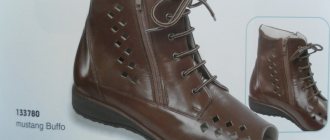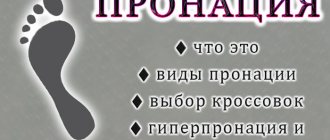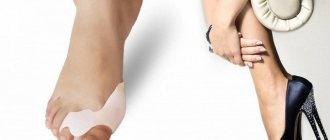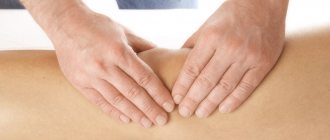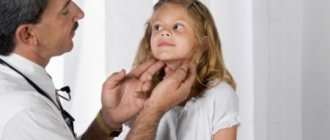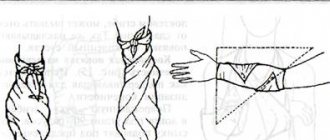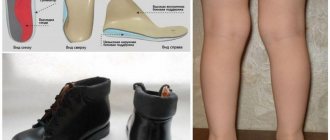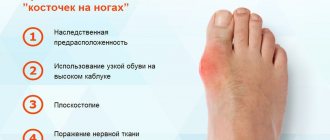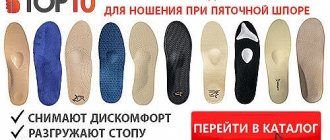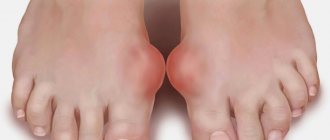Flat feet is a serious problem that, according to statistics, every second adult and child in our country faces. With it, the legs gradually lose their bending volume, the shape of the arch of the foot changes, and deformation (curvature) of the feet occurs. If corrective treatment is not started in the initial stages, then many changes may subsequently become irreversible.
In this article we will talk about factors that can provoke the development of flat feet, about the stages of the disease and how the right orthopedic shoes can correct existing signs of deformation and prevent further pathological changes.
Reasons for the development of flat feet
Flat feet very rarely develop out of the blue. Typically, such unwanted deformations occur due to:
- wearing uncomfortable, low-quality shoes;
- low physical activity.
- being overweight;
- constant increased loads on the feet.
Flat feet develop more often in people who are used to walking in low-toe shoes on flat surfaces (city asphalt) and much less often in those who find time to periodically walk along rocky paths, grass, and sand barefoot. In women, the problem often arises as a consequence of a significant increase in body weight during pregnancy.
To prevent serious disorders in the functioning of the musculoskeletal system, it is important to respond to the first “bells” as early as possible and contact a specialist who will help you choose the right shoes for flat feet and recommend effective corrective exercises.
Why do bones grow on my feet?
The causes of hallux valgus can be different: wearing poorly made shoes or shoes made of poor quality material, regular heavy load on the feet, genetic predisposition. Sometimes the cause is a combination of factors. And this is not the entire list.
People with this disease have to choose shoes for a long time, or buy special ones, for example, Sursil Ortho. All this takes time or requires additional money. Regular shoes can be painful and compress your feet. Therefore, people with this disease have to give up beautiful shoes in favor of comfortable sneakers and boots. And this can be very frustrating.
But comfortable shoes are not the solution to the problem. Valgus requires treatment, as without it it only gets worse.
- Firstly, pain increases.
- Secondly, the foot begins to deform even more, which can lead to restrictions in life and work. The thumb begins to bend towards the other fingers, overlapping with the other fingers.
Characteristic signs of flat feet
To check how correctly a child’s foot is forming, you can use this home diagnostic method: lubricate the baby’s feet with paint or rich cream and ask him to take a step on a clean sheet of paper. This way you will get a clear imprint of the child's foot and will be able to analyze it for any deformities.
If the characteristic notch at the inner edge of the foot on the print occupies less than half the width or is displayed entirely on the sheet, then you need to contact a specialist as soon as possible to confirm the diagnosis and receive recommendations for correcting the defect.
Attention! Until the age of 3, this diagnostic method does not make sense to use, since children still have an impressive fat pad in the sole area.
In adolescents and adults, flat feet can be suspected if the legs get tired quickly, after physical activity there is pain in the feet, the ankles constantly or periodically swell, there is a feeling that the width and length of the feet have increased.
Valgus Correction Device
At the initial stage, hallux valgus can even be cured if you choose the right shoes in time. And with a strong development of the disease, you can begin to use special corrective devices. They can be purchased both in specialized stores and on the Internet. It is important to ensure the quality of the device. Its essence is simple. Most often, the silicone device is placed on the finger and foot. It fixes the bone and protects it from pressure from shoes. The silicone layer prevents the shoe from rubbing against the bone, which significantly reduces pain.
Which pair to choose at different stages of deformation?
The choice of orthopedic product directly depends on the degree of flat feet. When identifying deformities, orthopedists recommend:
- Stage 1-2 (the first deforming changes, the legs get tired quickly, slight swelling may occur) - suede, nubuck products with orthopedic insoles with a small wide heel, with a tight heel, a round or square toe, lacing to control the density of the transverse girth; special inserts, finger holders; rejection of rigid wedges and platforms;
- Stage 3 (pronounced changes that can be detected even with a cursory visual examination) – constant wearing of orthopedic shoes, the choice of which must be monitored by a specialized specialist.
Where to buy orthopedic boots
In large cities there are specialized stores that distribute orthopedic shoes. You can also meet official representatives from the manufacturer’s brand.
Very often, such shoes are sold or made to order at a treatment center. In this case, the specialist puts a special last on the deformed leg, takes the readings, and then makes the shoes that the patient will wear in the future. Such boots and shoes will not be able to negatively interfere with the treatment process, so they can be worn even after surgery to remove Hallux Valgus.
Another option is to purchase orthopedic shoes online. In this case, you must be confident in the quality of the product, and also have the opportunity to try it on before paying.
3 / 5 ( 2 voices)
Women's shoes for flat feet
Flat feet can cause a woman a lot of inconvenience, because following fashion trends and the extremely unhealthy principle “beauty requires sacrifice,” they buy a pair of high heels, which only aggravates problems with the limbs.
When diagnosing a disease, experts recommend at least temporarily abandoning extremely high stiletto heels, but not going to extremes by choosing a product with a flat, inflexible sole. The optimal solution would be to buy medium-height shoes or sandals with heels up to 5 cm. When choosing a model, it is better to choose a pair made of soft leather, suede, nubuck, on the inside of which there are no seams that put additional pressure on problem areas that provoke the development of soft and hard calluses .
You should not ignore the disease at stages 1-2, because it is during this period that you can get by with “little blood” and return your feet to their normal shape. At the last stages, the deformations are already stable and it is almost impossible to correct them.
What is hallux valgus?
Hallux valgus is an orthopedic disease of people of different ages and gender. In adults, the disease most often appears after 30 years of age. According to orthopedic doctors, the diagnosis is made in 20-65% of cases when women complain of foot pain. For men, the percentage is lower – 5-15%. The disease is progressive.
When the disease occurs, the anatomy of the foot changes - a lump appears on the first toe, and the toe deviates away from its normal position. Pressure is exerted on the adjacent fingers, as a result of which they change shape, acquiring a “hammer-shaped” appearance. There is a general imbalance in the functions of the muscles, tendons, and ligaments of the foot. Its front part expands, and flat feet appear. In a normal state, when walking, support occurs on the first and last toes. The second, third, fourth form an arc with its apex on the bone of the third finger. With flat feet, all the toes fall like a fan, distributing the pressure among themselves. Changes in anatomy often lead to impaired blood circulation in the front part of the foot, which causes arthritis and arthrosis.
The curvature manifests itself in stages:
- At first, there is a feeling of discomfort when wearing familiar shoes. It seems that she has become smaller and has begun to squeeze her fingers. Choosing comfortable shoes in a store is becoming increasingly difficult - you have to buy a pair larger in size to avoid the feeling of pressure. This happens due to the fact that the angle of deflection of the finger increases;
- in the evening there is pain throughout the entire foot. Gradually, the pain “shifts” in time, appearing at any time of the day, and in place, “rising” to the ankle and calf muscles;
- the first finger deviates more and more noticeably to the side, becomes deformed - a growth-bump appears on the joint;
- other fingers are subject to deformation, transverse flatfoot develops;
- the curvature is noticeable to the naked eye, constant pain appears when walking.
The disease can be congenital or acquired. Congenital pathology occurs due to disturbances in the formation of the bones of the foot and their position during intrauterine development. The congenital disease manifests itself in the first few months after birth.
There are several reasons for the development of acquired “valgus foot”:
- muscle hypotonicity. Diagnosed in premature babies, newborns with poor health, and retarded physical development. Hypotonia is one of the signs of rickets. Long-term wearing of a cast can lead to hypotonia;
- improper development of ligaments, muscles, tendons, other diseases of the musculoskeletal system (for example, osteoporosis);
- some diseases - cerebral palsy, polio, dysplasia;
- injuries – fractures, sprains, foot dislocations;
- obesity. Too much weight increases pressure on the foot, especially the first toe, leading to flat feet;
- wrong shoes. The reason for the more frequent manifestation of the disease in women is narrow-toed high-heeled shoes. In these “pumps,” the body weight rests on the front of the foot. The foot becomes deformed and growths appear on the bone of the first toe. Therefore, it is not recommended to wear the “hairpin” for a long time; it should be worn only on special occasions for a maximum of 2 hours. For everyday wear, it is better to choose comfortable shoes with low, stable heels.
One of the common causes of deformity in children is standing on their feet too early, when the muscles and ligaments are not yet ready for such high loads. You can determine the curvature by watching how the child walks. With normal development, the leg is placed on the entire foot, with pathology - only on its inner part. Incorrect development can be determined by the way the shoes are worn - they are worn out on the inside.
The development of the disease is characterized by a violation of the shape of the lower part of the leg - in the form of the letter X. The gait becomes uncertain and awkward. Pathology appears not only externally. The child talks about pain in the ankle and back when walking, and avoids active games. By evening, your legs may swell and cramps in your calves begin. If the symptoms are left unattended, the disease progresses, and concomitant diagnoses appear - arthrosis, scoliosis, deformation of the knee and ankle joints.
Men's shoes for flat feet
Flat feet are traditionally even more common in men than in women. You can find a variety of men's orthopedic shoes on sale. When going to the store to choose corrective shoes or boots, we recommend that you be guided by the following criteria:
- flexible sole made of materials with a special structure;
- shoes should provide good fixation and uniform load distribution;
- matching pair to the size and individual characteristics of the foot. Shoes or boots should be moderately loose in length and fullness;
- the presence of special insoles of an anatomically correct shape, providing good shock absorption when walking;
- The choice of models with a wide toe is welcome. This solution helps prevent circulatory problems in the feet.
Special everyday and training shoes for flat feet may not look too different from ordinary ones, but their price, for obvious reasons, can be significantly higher.
Who produces comfortable shoes for problem feet
In total, doctors identify several manufacturers of high-quality orthopedic shoes for people with bunion deformities. The most popular and in demand include companies from Germany, Austria and Finland. You can find boots or shoes made in the USA or Poland.
Who produces comfortable shoes for problem feet
The most common manufacturers of such shoes, the models of which can most often be found in stores, are:
- Rieker (Germany);
- Gabor (Germany);
- Waldlaufer (Germany);
- Hogl (Austria);
- Janita (Finland).
Apart from the fact that these manufacturers make shoes that help you avoid many diseases, they also make them beautiful and elegant.
Medical models often look unattractive and are very massive and rough. With the named manufacturers, it is difficult to guess that your shoes are orthopedic. But the cost of such boots or shoes will be more expensive than their domestic counterparts.
Children's shoes for flat feet
Has your child been diagnosed with flat feet? In childhood, returning the feet to their normal shape is easier than fighting the disease in adulthood. To choose the right orthopedic shoes, you should first enlist the help of an experienced specialist. For successful correction, you need to bring your baby for preventive examinations to an orthopedist at least once every 3 months.
It is optimal to order corrective shoes in a special salon, where craftsmen will take individual measurements and make the right pair to order. Orthopedic shoes, boots, sandals for children must meet the following criteria:
- heel no more than 2 cm;
- flexible sole;
- laces or Velcro;
- tight back;
- high-quality instep support;
- anatomical insoles;
- breathable upper material.
To get the best results, it is recommended to combine wearing special shoes with doing exercises to strengthen muscles and attending therapeutic massage sessions.
What are orthopedic shoes?
The main task of any shoe is to protect the foot when moving. In sports sneakers, shock absorption and balance play an additional role; in work boots, a reinforced toe is used for insurance in case of accidents, etc. The main goal of orthopedic shoes is to eliminate or correct certain symptoms of a certain pathology.
At the same time, all others are subordinated to the main goal. Therapeutic shoes are not always the most beautiful or comfortable. In this sense, it can be compared to a plaster cast - the main thing in it is the result, not comfort or aesthetics. Therefore, when purchasing orthopedic sandals or boots, attention is paid primarily to its characteristics and effect.
Not all orthopedic shoes are therapeutic. There are many more purely preventive models on sale. And they are not at all bad for a healthy child. The characteristics of preventative shoes are a low heel, a neutral sole position and a very small arch support.
Children's shoes for the prevention of flat feet
Prevention is easier than treatment - this principle should be followed by parents who want to protect their child from a disease that can be considered one of the most common ailments of modern people.
To avoid problems with the musculoskeletal system, it is important to buy the right children's shoes when the baby is just learning to walk. To begin with, you should get slippers made of soft, breathable material that can be adjusted to your feet (with buckles, Velcro, laces). The sole should bend well.
The maximum height of the heel in childhood should not exceed 1.5-2 cm. This element should be wide, stable, and occupy at least a third of the area of the sole. Buying boots with a wide toe box will prevent deformation of the toes and the appearance of painful calluses. The foot in the shoe should not dangle, moving sideways or backwards.
Benefits of wearing shoes for problem feet
If you choose the right shoes for your feet with bones, you will immediately notice a number of positive aspects. Among them:
- maintaining the foot in the desired position;
- prevention of flat feet;
- prevention of various types of deformities, including hallux valgus;
- protection against compression and excessive stress;
- fixing the toes in the desired position;
- relieving pain;
- maintaining normal blood circulation in the feet.
It is worth noting that wearing such shoes has a beneficial effect on the spine, hip joints and the entire musculoskeletal system. In addition, your legs don’t get tired in it at all.
Benefits of wearing shoes for problem feet
What shoes should you not wear if you have flat feet?
After confirming the diagnosis of flat feet, you should immediately review your home shoe collection and stop wearing:
- models with rigid soles;
- shoes with wedges, platforms;
- high-heeled shoes;
- tight pairs with a narrow toe.
Today you can easily choose a stylish pair for any season from the collections of special orthopedic shoes. Such shoes, boots, sandals look no worse than ordinary ones, not endowed with orthopedic functions.
The disease should not be ignored in the early stages. Timely treatment and wearing corrective shoes will help to avoid serious consequences that cause such deformities, restore the shape of the foot as soon as possible and enjoy a full life without flat feet!
Which shoes complicate the problem of bunions?
People with this problem should avoid the following shoe models:
- too tight or wide;
- with narrow tight straps in the area of the phalanges of the fingers;
- with a flat, low sole;
- with poor fixation (flip-flops, flip-flops);
- with high and unstable heels (from 4 cm, in some cases from 7 cm);
- from artificial materials.
The wrong shoes or boots can aggravate your problem with a crooked first toe. Therefore, it is better to pay extra and buy high-quality orthopedic boots than to spend money on a dubious but beautiful product.
Primary requirements
You need to select orthopedic products taking into account certain factors:\
People with this problem should not wear patent leather shoes.
- Material. Shoes made with high quality should wear out well and quickly. It follows from this that the materials in the composition must be exclusively natural. This applies to both the top of the pair and the lining. The ideal option is shoes made of suede or smooth leather. Due to their hardness, varnished products are not suitable.
- Heel and sole. Models with flats or high heels should be avoided. If it is completely impossible to forget about the latter, a wedge heel would be a suitable solution. The optimal heel height is up to 4 cm.
- Insole. It can be used in regular shoes and combined with anatomical models. The main task of the insole is to correctly distribute the load when walking. The doctor will help you choose it.
WOMEN'S SHOES AXEL
A model that, according to customer reviews, feels “like slippers” on your feet. Very soft, perfect for wide, swollen feet, and also do not put any pressure on the area of the bunions and toes, thanks to the elastic inserts. The leather strap allows you to adjust the instep height and achieve a perfect fit of the shoe on your foot. Thanks to the toe of the correct anatomical shape, the toes feel free and comfortable. Removable insoles have a light anatomical texture and help relieve the load on the foot.
WOMEN'S ORTHOPEDIC SHOES DR SPEKTOR
Comfortable model made of natural combination leather for wide feet. The rounded area of the toe allows the toes to be in the anatomically correct position, the shoes do not squeeze them and prevent pain in the area of the “bones”. Using a leather strap, the low shoes are adjustable in height and securely fixed on the foot. The soft edging in the heel area prevents chafing. Removable insoles have arch support for the longitudinal and transverse arches, support the feet, and absorb shock when walking.
Or maybe without her?
After the operation, pain in the foot persists with any movement of the operated foot. The thought arises of just lying down on the couch for the entire recovery period - but it won’t hurt.
And at the same time, a sedentary lifestyle is not the right way out of the situation.
You need to move because physical activity maintains normal blood flow and the wound heals faster. The massive swelling that occurs in the first days after surgery will subside faster due to sufficient blood circulation. In addition, movement maintains the tone of ligaments and muscles.
And postoperative shoes are the main assistant here, because:
- Postoperative swelling disappears faster;
- less pain when moving;
- the recovery period is reduced.
WOMEN'S ORTHOPEDIC SNEAKERS WALDLAUFER ORTHOTRITT
Sneakers of German quality made of soft genuine leather, complemented by elastic inserts in the toe area and “bones” at the big toe, which allows you to reduce the pressure of the shoe on problem areas. The model is not only incredibly light and comfortable, but also looks stylish. Zippers sewn into the sides make putting them on much easier, since you no longer have to use lacing every time. Removable anatomical insoles with arch support for the longitudinal and transverse arches help prevent flat feet, reduce the load on the joints and spine and provide good shock absorption.
One or two?
Postoperative shoes are sold one shoe at a time. At the same time, it is universal: it is designed in such a way that one copy is suitable for both the right and left legs.
In some cases, the attending physician recommends purchasing a compensatory boot. There will be a postoperative unloading specimen on one leg, and a compensatory one on the other, for ease of movement.
Postoperative shoes will protect against severe pain during rehabilitation, help maintain physical activity from the first days of the recovery period and shorten the healing time of the foot.
Orthopedic salons of the Ortix network offer a wide selection of post-operative shoes and professional consultations from employees - so that you can make the right choice.
How: choose, wear, move?
There are no uniform standards for the wearing regimen and duration of use of postoperative shoes. The rules may vary depending on the details of the transaction. Therefore, the wearing regimen and duration are prescribed by the attending physician.
There is no uniform classification for postoperative shoe sizes. Each manufacturer has its own ideas about the size range L, M and S. Therefore, there are three options for selecting shoes:
- try on shoes directly in a specialized salon;
- measure the length of the foot and check this indicator when choosing a product;
- study the size correspondence table that each manufacturer accompanies its products.
It is important to remember that when choosing shoes, it is best to leave one centimeter in reserve along the length of the insole - the foot will feel comfortable, especially if there is a need to wear an extra sock.
The recovery period after surgery is associated with pain, so walking in operating shoes will be careful if you wish. The wedge-shaped sole is stable and easy to use, and at the same time, accuracy and care when using postoperative shoes will ensure complete safety of movement.
NURSING CARE ARRABIDA SHOES
When you need the softest and widest slippers that will securely hold your foot, the ARRABIDA model is an excellent option. The textile upper and lining make them easy to care for - just machine wash them, and also allows you to maintain the necessary air and moisture exchange inside the shoes. Slippers are well suited for problem wide feet, for conditions after injuries and operations, as well as for severe swelling. Removable insoles have instep support for the longitudinal and transverse arches. The model opens completely and is easily adjustable for fullness and height using Velcro.
ORTHOMS LOW BOOTS
The widest and softest model, which is perfect for full legs and swollen ankles. They open all the way to the toe and are easily adjusted with leather straps for lift and fullness, so putting them on is very easy. The seamless textile lining prevents chafing, making the low shoes suitable for diabetic feet. Removable latex insoles with a light anatomical relief allow you to relieve the joints and spine and carefully support the feet from below.
WOMEN'S ORTHOPEDIC BOOTS AXEL
Low shoes of amazing softness that will suit even the most sensitive and painful feet. The top of the cape and the area of the “bones” of the big toe are made of elastic material, which is absolutely not felt on the foot and does not put pressure on the joints. Textile lining prevents chafing. A wide leather strap regulates the instep height and secures the shoes on the foot. Stable, very light and wide low shoes with removable orthopedic insoles that carefully support the arches of the feet.
